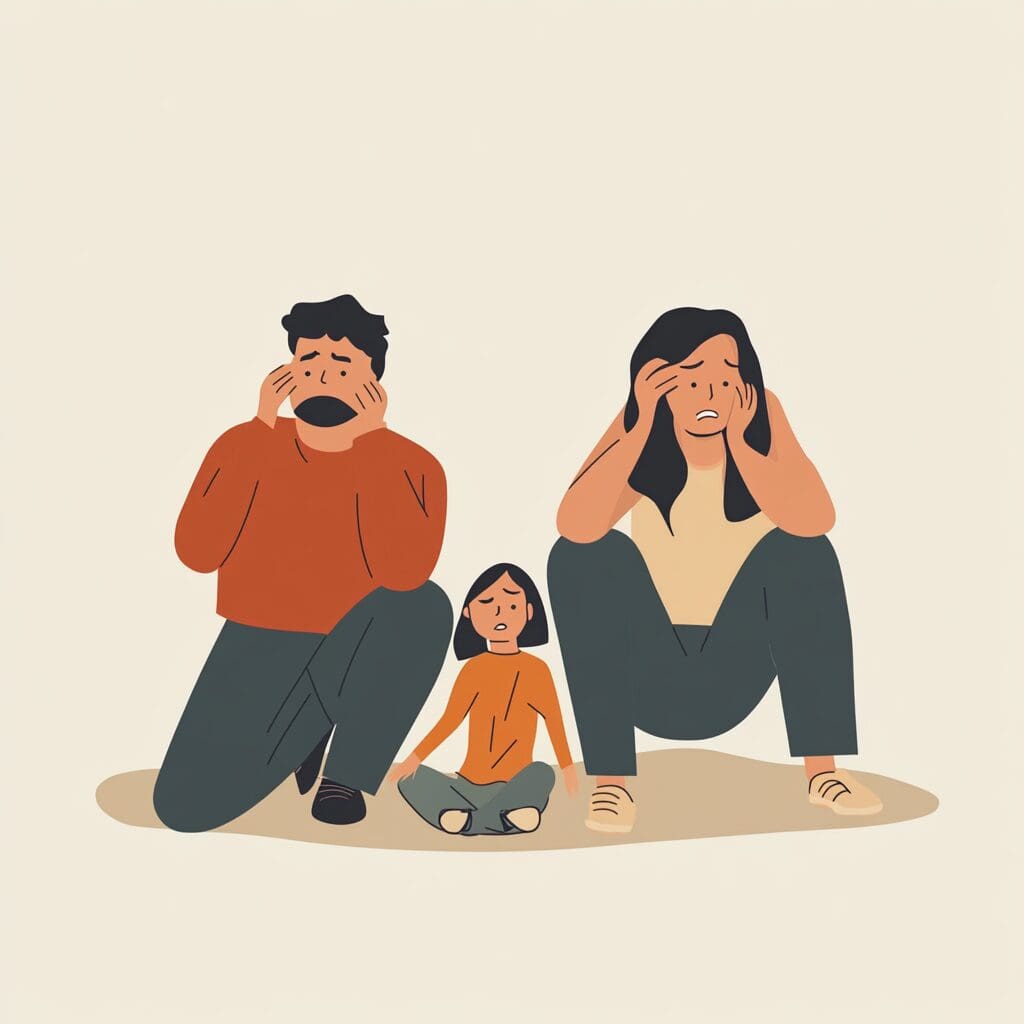Raising a child with ADHD can be both rewarding and challenging, as ADHD often brings creativity, enthusiasm, and spontaneity alongside intense emotional outbursts, impulsivity, and difficulties with routines.
These behaviours are not due to poor parenting but stem from a neurodevelopmental condition that affects impulse control and information processing. For many parents, this journey involves managing emotions, from joy and love to frustration and exhaustion.
Similar to parenting a child with anxiety, balancing empathy and guidance while addressing one’s emotional responses can feel overwhelming, leading many to seek effective strategies to support their child and themselves.
Dialectical Behaviour Therapy (DBT) offers a valuable framework for addressing these challenges. Initially designed for borderline personality disorder, DBT’s four components—Mindfulness, Emotional Regulation, Distress Tolerance, and Interpersonal Effectiveness—are now widely recognized for their applicability across various mental health conditions, including ADHD.
Unlike therapies focused solely on the individual, DBT’s skills can be used within family dynamics to foster emotional stability and effective communication. This article explores how DBT techniques can empower families to manage ADHD’s unique demands, providing both immediate coping tools and a foundation for lasting family harmony and growth.
Understanding ADHD and Its Challenges in Parenting
Parenting is always a blend of joy, responsibility, and constant learning. When raising a child with Attention Deficit Hyperactivity Disorder (ADHD), these dynamics often intensify, bringing unique challenges that can test even the most experienced caregivers. Understanding the nature of ADHD and its specific challenges is the first step in building a practical and compassionate approach to supporting your child.
What is ADHD?
ADHD is a neurodevelopmental disorder that affects how the brain regulates attention, impulsivity, and activity levels. Children with ADHD may display a range of behaviours that can be confusing and overwhelming for both themselves and those around them. Symptoms of ADHD often fall into three main categories:
- Inattention: Difficulty sustaining focus, easily distracted, struggling with organisation, and needing to be more mindful.
- Hyperactivity: Constant movement or fidgeting, an inability to stay seated or quiet, especially in settings where it’s expected.
- Impulsivity: Acting without thinking, difficulty waiting for their turn, and frequently interrupting during conversations.
While each child with ADHD is unique, these behaviours can affect many aspects of daily life, from school performance and friendships to family interactions. Children with ADHD often struggle to follow instructions, keep up with homework, and participate in structured activities, which can be frustrating for both them and their caregivers.
The Challenges of Parenting a Child with ADHD
Parenting a child with ADHD involves not only addressing the child’s needs but also managing one’s own emotions and expectations. Here are some common challenges that parents may encounter:
- Managing Impulsive Behaviour: Children with ADHD often act without considering the consequences, whether it’s running into the street, interrupting conversations, or breaking household rules.
- Handling Emotional Outbursts: ADHD is often associated with heightened emotional sensitivity, which can result in intense and unpredictable outbursts. Frustrations may escalate quickly into meltdowns, and the child may struggle to calm down independently.
- Maintaining Structure and Routines: Children with ADHD benefit from predictable routines but may have difficulty sticking to them. This can mean daily battles over bedtime, meal times, and homework for parents.
- Navigating Social Challenges: Children with ADHD may struggle with social cues and maintaining friendships. They may interrupt others, have trouble taking turns, or misread others’ emotions, leading to isolation or bullying.
- Balancing Discipline with Compassion: Discipline is complex when dealing with ADHD. Traditional approaches, like timeouts or reprimands, may not be beneficial and can sometimes exacerbate the child’s frustration or sense of rejection.
The Emotional Impact on Parents
The challenges of parenting a child with ADHD often extend beyond daily behaviours, impacting the mental and emotional well-being of parents as well. It’s common for parents to feel a mix of emotions, including:
- Frustration and Exhaustion: The constant energy required to manage impulsivity, regulate emotional outbursts, and maintain routines can lead to physical and emotional exhaustion.
- Guilt and Self-Doubt: Parenting a child with ADHD often brings moments of guilt and self-doubt. Parents may question their abilities, feel they aren’t providing enough support, or worry they’re at fault for their child’s struggles.
- Stress and Anxiety: The unpredictability of ADHD-related behaviours, combined with concerns about their child’s future, often contributes to high levels of stress and anxiety in parents.
Recognising and validating these challenges is essential for parents. It is normal to feel these emotions, and seeking support—whether from a therapist, support group, or friends and family—can provide relief and reassurance.
Why DBT Can Be a Valuable Tool for Caregivers of Children with ADHD
While the challenges of ADHD are prevalent, there are practical strategies that can help both children and parents manage the symptoms and improve family dynamics. Dialectical Behaviour Therapy (DBT) has proven effective in helping individuals and families cope with a range of emotional and behavioural challenges. DBT’s emphasis on mindfulness, emotional regulation, distress tolerance, and interpersonal effectiveness provides a toolkit for parents to approach ADHD-related challenges more confidently, empathetically, and calmly.
DBT is recognised as a versatile therapeutic approach, valuable for individuals struggling with emotional regulation, impulsive behaviours, and relationship challenges—issues that are common for people with ADHD. DBT’s skills-based framework can help children with ADHD, as well as their caregivers, to effectively manage symptoms in a supportive and structured way.
DBT consists of four primary components, each designed to build skills that can improve quality of life and emotional well-being:
- Mindfulness focuses on staying present in the moment and becoming aware of one’s thoughts, feelings, and surroundings without judgment. This skill can be beneficial for children with ADHD who often find themselves distracted or overwhelmed by their environment.
- Emotional Regulation teaches individuals to identify, understand, and manage intense emotions. For children with ADHD, this is crucial because they often experience rapid and intense emotional shifts that can be difficult to control.
- Distress Tolerance equips individuals with tools to cope with difficult or overwhelming situations without resorting to impulsive reactions. Children with ADHD may struggle with frustration and self-control, making distress tolerance skills beneficial for managing these challenging moments.
- Interpersonal Effectiveness helps individuals communicate, set boundaries, and build healthy relationships. This is particularly relevant for children with ADHD, who may struggle with social interactions, often misinterpreting social cues or acting impulsively.
Practical Tips for Implementing DBT Skills at Home
Integrating DBT skills into daily routines at home can make these tools more accessible and practical (read more about The Power of Routines here). Practising DBT consistently and creatively helps children with ADHD and their caregivers build resilience, improve self-regulation, and create a supportive family environment. Here are practical ways to incorporate DBT skills into family life:
1. Establishing a Family Routine for Practising DBT Skills
Consistency helps everyone stay on track and makes DBT skills feel natural over time.
- Daily Mindfulness Moments: Start each day with a simple mindfulness exercise, like three deep breaths or a one-minute “quiet time.” This practice helps the family start with a calm mindset and builds focus.
- Family Check-ins: Dedicate a few minutes each evening for family members to share “highs” and “lows” from their day. This encourages open communication and emotional expression and builds support.
- Weekly Skill-Building Time: Set aside one evening each week to practise a specific DBT skill as a family, such as distress tolerance or using “I feel” statements, building skills gradually over time.
2. Using Visual Aids and Reminders
Visual reminders help reinforce skills, especially for children struggling with memory or focus.
- Emotion Charts and DBT Skill Posters: Place emotion charts and posters with DBT skills around the home to provide easy references during stressful moments. For example, a “calm-down corner” could include a poster of calming techniques.
- Feelings Thermometer: Use a “feelings thermometer” to help children gauge the intensity of their emotions, helping them understand when to use a DBT skill to manage strong feelings.
3. Setting Realistic Expectations and Celebrating Progress
Consistency in practising DBT skills takes time, so celebrating small steps helps keep everyone motivated.
- Start Small: Begin with one or two manageable skills, such as deep breathing or “I feel” statements, and gradually add more.
- Acknowledge Small Wins: Praise progress, like using a distress tolerance technique, to reinforce positive behaviour.
- Encourage Self-Reflection: Ask children how they feel after practising a skill to reinforce self-awareness and help them see the benefits.
4. Fostering Self-Compassion for Parents and Children
Self-compassion helps everyone stay patient, especially during setbacks.
- Model Kindness to Yourself: Show children it’s okay to make mistakes by speaking kindly to yourself. For instance, say, “I tried my best, and that’s enough for today.”
- Teach Positive Self-Talk: Encourage children to use affirming phrases like “I can try again,” building their resilience.
- Use the “Mistakes are Learning” Approach: Emphasise that learning takes time and celebrates efforts rather than perfection.
5. Making DBT Practice Fun and Engaging
Integrating play into DBT practice keeps children engaged and encourages regular use of skills.
- Incorporate Games: Use games like “Simon Says” to practise skills like mindfulness or turn-taking games for patience and impulse control.
- Reward Systems: Use charts or sticker rewards to practise skills like deep breathing and reinforce positive behaviour.
- Family DBT Challenges: Create shared goals by setting up weekly “DBT challenges,” like practising mindfulness daily for a week and celebrating at the end.

Long Term Benefits of Implementing DBT Practices
Parenting a child with ADHD is both rewarding and challenging, as ADHD can bring unique strengths, like creativity and enthusiasm, along with difficulties that impact family dynamics.
Dialectical Behaviour Therapy (DBT) offers flexible, accessible skills for managing impulsivity, regulating emotions, improving focus, and fostering healthy relationships—often complicated by ADHD. DBT can be practised at home, woven into daily routines, and tailored to each family’s needs, helping children develop self-awareness and emotional control while providing parents a framework for mindful, compassionate parenting.
As families adopt DBT’s mindfulness, emotional regulation, distress tolerance, and interpersonal skills, they build a shared vocabulary that fosters a supportive environment, reduces stress, and strengthens bonds.
DBT also reminds parents of the importance of self-care and self-compassion, encouraging them to embrace each small victory and remain patient throughout the journey. With time and practice, DBT can transform not only a child’s ability to navigate ADHD but also the family’s overall resilience, connection, and joy.
FAQ's
- DBT can be adapted for children as young as six, with age-appropriate mindfulness and emotional regulation methods.
Integrate DBT into daily routines in a fun and engaging way, such as using games, visual aids, and regular family practice sessions.
- It’s natural to feel this way; practising self-compassion and distress tolerance can help manage these moments.
- DBT is a complement, not a replacement, for medical treatment. It focuses on skill-building and can work alongside medications prescribed by a healthcare provider.
- Yes, breathing, mindfulness, and grounding exercises can help children slow down and manage impulsive urges.


